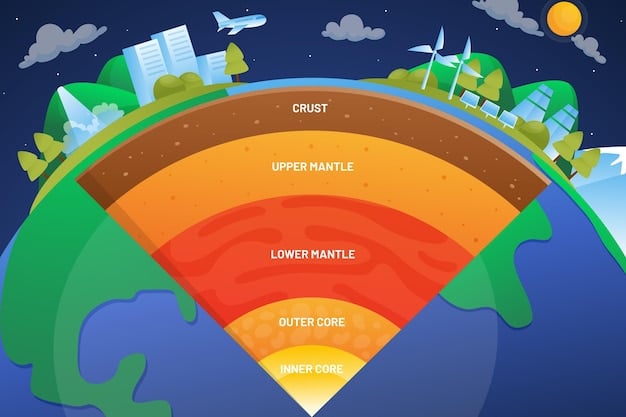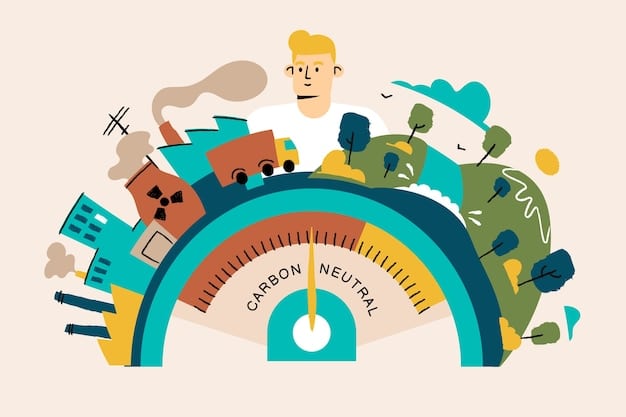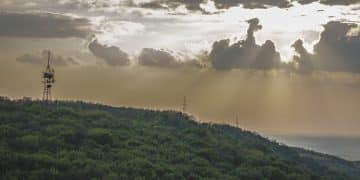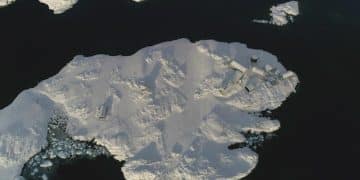Climate Change Science: Evidence & Future Impact

Advertisements
The science behind climate change definitively links increasing global temperatures to human activities, primarily the emission of greenhouse gases, presenting profound implications for future environmental and societal stability worldwide.
Advertisements
Delving into The Science Behind Climate Change: Understanding the Evidence and What It Means for the Future is no longer an academic exercise but an urgent imperative. From shifting weather patterns to rising sea levels, the planet is experiencing profound changes, prompting critical questions about our shared future. This comprehensive exploration aims to dissect the core scientific principles and robust evidence underpinning our current understanding of this pressing global phenomenon.
The Definitive Indicators of a Warming Planet
The observable signs of a warming planet are unequivocal, providing a robust foundation for understanding the reality of climate change. Scientists employ a variety of methods and data sources to monitor these changes, painting a consistent picture of a system undergoing rapid transformation. The interconnectedness of these indicators reinforces the scientific consensus on global warming.
Advertisements
Global Temperature Anomalies
One of the most direct and compelling pieces of evidence is the increase in average global temperatures. Data from meteorological stations, ocean buoys, and satellite records consistently show a warming trend over the past century, with the most significant increases occurring in recent decades. This isn’t merely about warmer days; it’s about a sustained shift in the Earth’s energy balance.
- Record-breaking Heat: Numerous years in the 21st century have been recorded as the hottest on record, indicating a monotonic rise in global averages.
- Widespread Warming: Temperature increases are observed across continents and oceans, affecting both land and sea environments.
- Accelerated Warming Rate: The rate of warming has accelerated significantly since the mid-20th century, distinguishing current trends from natural climate variability.
Shrinking Ice Sheets and Glaciers
The ongoing retreat of glaciers and polar ice sheets serves as a stark visual testament to rising temperatures. These vast reservoirs of frozen water are melting at an unprecedented pace, contributing to sea level rise and altering regional ecosystems. The sheer volume of ice loss documented by scientific missions is staggering.
For instance, the Greenland and Antarctic ice sheets, crucial to global sea levels, are losing mass at an accelerating rate. This meltwater not only adds to ocean volume but also affects ocean currents and salinity, potentially disrupting vital marine life. Alpine glaciers, often sources of freshwater for downstream communities, are also diminishing rapidly, impacting water security.
The loss of sea ice in the Arctic, particularly the summertime minimum, is another critical indicator, impacting wildlife like polar bears and potentially disrupting global weather patterns due to changes in oceanic and atmospheric circulation.
Evidence from Satellite Data
Satellite imagery provides an invaluable, comprehensive, and continuous record of these changes, allowing scientists to quantify the rate of ice loss and its spatial distribution. This observational data complements ground-based measurements, establishing a consistent and alarming trend.
The conclusion drawn from these definitive indicators is clear: our planet is warming at an alarming rate, and the physical manifestations of this warming are becoming increasingly evident across diverse environments.
The Greenhouse Effect: Core Mechanism of Warming
Understanding the greenhouse effect is fundamental to comprehending climate change. This natural process is essential for life on Earth, trapping some of the sun’s energy within our atmosphere and maintaining a habitable temperature. However, human activities are intensifying this effect, leading to an imbalance that drives global warming.
How Greenhouse Gases Trap Heat
Certain gases in our atmosphere, known as greenhouse gases (GHGs), have a unique property: they absorb and re-emit infrared radiation from the Earth’s surface. This process prevents heat from escaping directly into space, effectively warming the planet. Without these gases, Earth’s average temperature would be significantly lower, resembling a frozen wasteland.
- Absorption and Emission: GHG molecules absorb thermal radiation, becoming energized, and then re-emit this energy in all directions, including back towards the Earth’s surface.
- Atmospheric Blanket: This continuous absorption and re-emission act like a blanket, trapping heat and regulating the Earth’s temperature.
- Specific Gases: Key greenhouse gases include carbon dioxide (CO2), methane (CH4), nitrous oxide (N2O), and fluorinated gases, each with varying capacities to trap heat.
The Human Fingerprint: Anthropogenic Emissions
While the greenhouse effect is natural, human activities have dramatically increased the concentration of GHGs in the atmosphere, primarily since the Industrial Revolution. The burning of fossil fuels for energy, deforestation, and industrial processes are the main culprits behind this surge.
Carbon dioxide, the most abundant anthropogenic GHG, accounts for the largest portion of human-induced warming. Its concentration in the atmosphere has risen by over 40% since pre-industrial times, reaching levels not seen in hundreds of thousands of years. This increase is directly traceable to human emissions through isotopic analysis, which reveals the “signature” of fossil fuel combustion.

Sources of Anthropogenic Emissions
The primary sources of elevated GHG concentrations are diverse, reflecting the complexity of modern industrial society. Each sector contributes uniquely to the atmospheric burden of these heat-trapping gases.
- Energy Production: Fossil fuels (coal, oil, natural gas) burned for electricity, heating, and transportation are the largest contributors.
- Industrial Processes: Manufacturing cement, steel, fertilizers, and other goods releases significant amounts of CO2 and other GHGs.
- Agriculture: Livestock farming (methane), rice cultivation, and fertilizer use (nitrous oxide) are major agricultural sources.
- Land Use Changes: Deforestation reduces the planet’s ability to absorb CO2, while land clearing often involves burning, releasing stored carbon.
The indisputable link between human activity and the increased concentration of greenhouse gases in the atmosphere is the bedrock of climate change science. It explains why the planet is warming beyond natural variability and provides a clear impetus for action.
Oceanic Absorption: A Double-Edged Sword
The world’s oceans play a crucial, yet often underappreciated, role in regulating Earth’s climate. They act as massive heat and carbon sinks, absorbing a significant portion of the excess heat and carbon dioxide generated by human activities. However, this absorption comes with severe consequences, transforming the marine environment and escalating climate change challenges.
Oceans as Heat Sinks
Oceans have absorbed over 90% of the excess heat trapped by greenhouse gases since the mid-20th century. This immense thermal buffering capacity has, in part, shielded land surfaces from even more dramatic temperature increases. However, the accumulation of heat in the oceans is not without its own set of profound implications.
Warmer oceans expand, contributing significantly to global sea level rise. This thermal expansion is already impacting coastal communities worldwide. Furthermore, elevated ocean temperatures are directly linked to the increased intensity of tropical storms and hurricanes, as warmer waters provide more energy for these systems to develop and strengthen.
Impacts of Ocean Warming
- Thermal Expansion: Warmer water occupies more volume, leading to higher sea levels and increased coastal flooding.
- Marine Heatwaves: Prolonged periods of unusually warm ocean temperatures stress marine ecosystems, causing coral bleaching and fish mortality.
- Disrupted Ocean Currents: Changes in temperature and salinity can alter crucial ocean currents, impacting weather patterns globally.
Ocean Acidification: A Silent Threat
Beyond heat, oceans also absorb approximately 25-30% of anthropogenic CO2 emissions. While this helps remove CO2 from the atmosphere, it triggers a chemical reaction in seawater that leads to ocean acidification. When CO2 dissolves in water, it forms carbonic acid, increasing the acidity (lowering the pH) of the oceans.
This process poses a grave threat to marine life, particularly organisms that build shells and skeletons from calcium carbonate, such as corals, shellfish, and certain plankton. As the ocean becomes more acidic, it becomes harder for these organisms to form and maintain their protective structures, jeopardizing entire marine food webs.
Consequences of Acidification
The implications of ocean acidification extend far beyond individual species, threatening the health and productivity of entire marine ecosystems which provide food and livelihoods for billions of people.
- Shell-building Schwierigkeiten: Organisms like corals, oysters, and mussels struggle to form or maintain their calcified shells and skeletons.
- Ecosystem Disruption: Shifts in basic ocean chemistry can alter food chains, impacting fish populations and biodiversity.
- Economic Impacts: Fisheries and aquaculture industries face significant threats due to declining shellfish and fish stocks.
The oceans’ critical role as climate regulators highlights the interconnectedness of Earth’s systems. While they mitigate atmospheric warming, the marine environment itself bears the brunt of these changes, setting off a cascade of ecological and economic consequences that require urgent attention.
Extreme Weather Events: A New Normal?
One of the most perceptible and alarming manifestations of climate change is the increasing frequency and intensity of extreme weather events. While linking any single event directly to climate change can be complex, the scientific consensus points to a clear trend: a warming planet creates conditions conducive to more severe and disruptive weather phenomena.
Heatwaves and Droughts
Rising global temperatures naturally lead to more frequent and prolonged heatwaves. These extreme heat events contribute to increased evaporation, exacerbating droughts in many regions. The combination of heat and dryness creates ripe conditions for wildfires, as seen in recent years across several continents.
Droughts have profound impacts on agriculture, water resources, and human health. They can lead to crop failures, food insecurity, and increased competition for dwindling freshwater supplies. Prolonged heat can also strain energy grids as demand for cooling skyrockets, leading to power outages and public health crises.
Intensified Storms and Flooding
A warmer atmosphere holds more moisture. For every 1°C increase in global temperature, the atmosphere can hold approximately 7% more water vapor. This increased moisture fuels more intense precipitation events, leading to heavier rainfall and increased flooding, even in areas not traditionally prone to it.
Furthermore, warmer ocean waters provide more energy for tropical storms and hurricanes, potentially increasing their intensity and destructive power. While the number of storms might not always increase, the proportion of storms reaching higher categories (e.g., Cat 4 and 5) appears to be rising, causing more widespread damage and displacing communities.
Impacts on Infrastructure and Society
- Infrastructure Damage: Flooding, strong winds, and extreme heat can damage roads, bridges, power lines, and buildings.
- Agricultural Losses: Droughts and floods devastate crops, impacting food supply chains and farmer livelihoods.
- Public Health Crises: Heat stress, respiratory illnesses from wildfire smoke, and waterborne diseases post significant health risks.
- Displacement: Communities in vulnerable regions face increased risk of displacement due to severe weather.
The shift towards a “new normal” of more extreme weather events demands enhanced resilience and adaptation strategies. It underscores the urgency of mitigating climate change to reduce the severity and frequency of these disruptive occurrences globally.

Sea Level Rise: A Growing Threat to Coastal Regions
Global average sea level has been steadily rising for over a century, and the rate of increase has accelerated in recent decades. This phenomenon is a direct consequence of a warming planet and poses one of the most immediate and pervasive threats to coastal populations and ecosystems worldwide.
Causes of Sea Level Rise
The primary drivers of global sea level rise are thermal expansion of ocean water and the melting of glaciers and ice sheets. Understanding these mechanisms is crucial to projecting future sea level trajectories.
As the oceans absorb excess heat from the atmosphere, the water itself expands, occupying more volume. This thermal expansion accounts for about one-third to one-half of the observed sea level rise. The remaining contribution comes from the melting of ice: mountain glaciers, the Greenland Ice Sheet, and the Antarctic Ice Sheet are all losing mass at an accelerating pace, adding vast quantities of meltwater to the oceans.
While local factors such as land subsidence or uplift can influence relative sea level in specific locations, the global average trend is driven by these large-scale climate processes.
Key Contributors to Sea Level Rise
- Thermal Expansion: Ocean water expands as it warms, increasing its volume.
- Glacier Melt: Runoff from melting mountain glaciers contributes freshwater to oceans.
- Ice Sheet Loss: The massive Greenland and Antarctic ice sheets are losing billions of tons of ice annually.
Impacts on Coastal Communities and Ecosystems
Even small increases in average sea level can have profound and widespread impacts, exacerbating existing vulnerabilities in coastal areas. These effects are already being observed and are projected to intensify significantly in the coming decades.
Rising seas increase the frequency and severity of coastal flooding during high tides and storm surges. This “nuisance flooding” can disrupt daily life, damage infrastructure, and affect property values. Critical infrastructure such as roads, wastewater treatment plants, and energy facilities located in low-lying coastal areas become increasingly vulnerable.
Saltwater intrusion into freshwater aquifers used for drinking water and agriculture is another severe consequence, jeopardizing water supplies and agricultural productivity. Coastal ecosystems, such as wetlands and mangroves, which provide vital protection against storm surges and act as nurseries for marine life, are also threatened as they struggle to adapt to the changing water levels.
Socio-economic and Environmental Consequences
The implications of rising sea levels are far-reaching, encompassing economic, social, and ecological dimensions that demand comprehensive adaptation and mitigation strategies.
- Increased Flooding: More frequent and severe coastal inundation, damaging property and infrastructure.
- Erosion of Coastlines: Accelerating erosion rates, leading to loss of land and habitats.
- Saltwater Intrusion: Contamination of freshwater sources, impacting drinking water and agriculture.
- Ecosystem Loss: Wetlands, marshes, and coral reefs are threatened as they fail to keep pace with rising water.
- Displacement: Low-lying coastal areas may become uninhabitable, forcing population migration.
The trajectory of sea level rise is heavily dependent on future greenhouse gas emissions. Without significant reductions, the long-term changes to our coastlines will be irreversible, reshaping geographies and demanding unprecedented adaptation efforts.
Future Implications and Projections: What Lies Ahead?
Understanding the current state of climate change naturally leads to critical questions about the future. Scientists use sophisticated climate models to project how the Earth’s climate will evolve under different greenhouse gas emission scenarios. These projections, while not predictions, offer vital insights into potential future impacts and guide policy decisions.
Climate Models and Emission Scenarios
Climate models are complex computer simulations that integrate physics, chemistry, and biology to simulate the Earth’s climate system. They are validated against historical data and past climate events, providing a powerful tool for understanding future changes. These models run various “emission scenarios,” which are plausible pathways of future greenhouse gas emissions based on different socio-economic developments, policy choices, and technological advancements.
The Intergovernmental Panel on Climate Change (IPCC), the leading international body for assessing climate change, uses these scenarios to outline potential future temperature increases, sea level rise, and changes in extreme weather. The range of potential futures is vast: from relatively contained warming under aggressive emission reductions to catastrophic warming if current trends continue unabated.
Key Parameters in Climate Projections
- Global Temperature Increase: Projections for average surface temperature rise by the end of the century.
- Sea Level Rise: Estimated increases in global mean sea level, considering thermal expansion and ice melt.
- Frequency of Extremes: Changes in the likelihood and intensity of heatwaves, heavy precipitation, and droughts.
Long-Term Climate Impacts and Feedback Loops
The future implications extend far beyond immediate temperature and sea level changes. Climate change is a complex system with potential feedback loops that could amplify warming and create irreversible consequences. For instance, the melting of Arctic permafrost could release vast stores of methane, a potent greenhouse gas, further accelerating warming.
Other concerns include the potential for large-scale ecosystem shifts, leading to significant biodiversity loss. Changes in ocean circulation could alter regional climates, impacting agriculture and water availability. The acidification of oceans continues to threaten marine life, with cascading effects through the food web.
Potential Tipping Points and Irreversible Changes
Scientists are particularly concerned about “tipping points,” thresholds beyond which certain parts of the climate system undergo abrupt and irreversible changes. Examples include the collapse of major ice sheets, leading to meters of sea level rise over centuries, or fundamental shifts in atmospheric and oceanic circulation patterns. While the exact timing of such events is uncertain, the risk increases with continued warming.
The projections underscore that the choices made today about greenhouse gas emissions will profoundly shape the world for generations to come. Limiting warming to 1.5°C or 2°C above pre-industrial levels requires unprecedented global cooperation and rapid decarbonization across all sectors.
Mitigation and Adaptation: Charting a Path Forward
The scientific evidence of climate change is clear, laying bare the urgency for a two-pronged approach: mitigation, to reduce the root causes of warming, and adaptation, to cope with the unavoidable impacts. Both strategies are essential for charting a sustainable path forward in a changing climate.
Mitigation Strategies: Reducing Emissions
Mitigation involves actions aimed at reducing or preventing the emission of greenhouse gases. The overarching goal is to stabilize atmospheric GHG concentrations at a level that would prevent dangerous anthropogenic interference with the climate system. This requires a systemic transformation of how we produce and consume energy, manage land, and conduct industrial processes.
Transitioning from fossil fuels to renewable energy sources like solar, wind, and hydropower is paramount. Enhancing energy efficiency in buildings, transportation, and industry also plays a critical role. Protecting and restoring forests, which act as carbon sinks, and improving sustainable agricultural practices are also vital mitigation efforts. Technological innovations in carbon capture and storage are also being explored, though their widespread deployment remains a challenge.
Key Mitigation Pillars
- Renewable Energy Transition: Shifting from fossil fuels to solar, wind, hydro, and geothermal power.
- Energy Efficiency: Reducing energy consumption in homes, transport, and industry.
- Sustainable Land Use: Reforestation, afforestation, preventing deforestation, and sustainable agriculture.
- Carbon Capture Technologies: Developing and deploying technologies to remove CO2 from the atmosphere or emissions.
Adaptation Strategies: Building Resilience
Even with aggressive mitigation efforts, some degree of climate change impacts is unavoidable due to past emissions. Adaptation refers to actions taken to adjust to actual or expected future climate. The goal of adaptation is to reduce vulnerability and build resilience in human and natural systems.
Examples of adaptation include building sea walls and improving drainage systems to protect coastal communities from rising sea levels and increased flooding. Developing drought-resistant crops and implementing efficient water management techniques are crucial for agriculture in changing precipitation patterns. Early warning systems for extreme weather events, and establishing green infrastructure in urban areas to manage heat and storm runoff, are also critical adaptive measures.
Examples of Adaptation Initiatives
Adaptation needs vary significantly by region and community, requiring localized solutions tailored to specific vulnerabilities and resources. These initiatives often involve multi-stakeholder collaboration and significant investment.
- Coastal Protection: Building seawalls, restoring mangroves, and elevating structures to defend against sea level rise and storm surges.
- Water Management: Developing rainwater harvesting, efficient irrigation, and desalinization plants to address water scarcity.
- Resilient Agriculture: Cultivating drought-resistant crops, diversifying farming practices, and improving soil health.
- Emergency Preparedness: Strengthening early warning systems for floods, heatwaves, and storms.
- Ecosystem Restoration: Protecting and restoring natural ecosystems that buffer against climate impacts.
Mitigation and adaptation are not mutually exclusive but complementary strategies. Robust mitigation can reduce the scale of future adaptation challenges, while effective adaptation can protect communities and ecosystems from the impacts that are already inevitable. A holistic approach that integrates both is the most effective way to address the complexities of climate change.
| Key Indicator | Brief Description |
|---|---|
| 🌡️ Global Warming | Consistent rise in Earth’s average surface temperature since the late 19th century. |
| 🧊 Ice Loss | Significant melting of glaciers, ice sheets, and Arctic sea ice, documented globally. |
| 💧 Sea Level Rise | Oceans expanding from warmth and receiving meltwater, threatening coastal areas. |
| 💨 GHG Emissions | Human activities, primarily fossil fuel burning, releasing heat-trapping gases. |
Frequently Asked Questions about Climate Change Science
▼
The primary scientific evidence for human-caused climate change comes from multiple lines of inquiry. This includes the direct measurement of increasing greenhouse gas concentrations in the atmosphere, alongside the observed rise in global temperatures, retreat of glaciers, and shrinking ice sheets. Isotopic analysis of atmospheric carbon dioxide specifically links its increase to the burning of fossil fuels.
▼
The greenhouse effect is a natural process where certain gases in Earth’s atmosphere trap heat. Greenhouse gases (like CO2 and methane) absorb infrared radiation emitted from the Earth’s surface and re-emit it, warming the planet. Human activities have significantly increased the concentration of these gases, intensifying this natural effect and leading to excessive warming.
▼
While no single extreme weather event can be solely attributed to climate change, scientific research indicates that a warming climate is increasing the frequency and intensity of many such events. This includes more severe heatwaves, prolonged droughts, and heavier precipitation leading to floods, as well as an increase in the destructive potential of tropical storms due to warmer ocean waters.
▼
Global sea level rise is primarily caused by two factors: the thermal expansion of ocean water as it warms and the melting of glaciers and polar ice sheets. As the oceans absorb excess heat, the water expands. Simultaneously, meltwater from diminishing ice bodies flows into the oceans, directly adding to their volume. Both processes are accelerating.
▼
Addressing climate change requires a dual approach: mitigation and adaptation. Mitigation involves reducing greenhouse gas emissions through transitioning to renewable energy, improving energy efficiency, and sustainable land use. Adaptation focuses on building resilience to unavoidable impacts, such as developing drought-resistant crops, enhancing coastal defenses, and improving early warning systems for extreme weather events.
Conclusion
The journey through the science behind climate change reveals an intricate web of evidence, mechanisms, and cascading impacts. The data is unequivocal: Earth’s climate is changing at an unprecedented rate, predominantly driven by human activities. From the definitive indicators of rising global temperatures and retreating ice to the profound shifts in ocean chemistry and the increasing frequency of extreme weather events, the scientific community has meticulously documented the planetary transformation underway. Understanding these realities is not merely an academic pursuit; it is the essential first step toward formulating effective mitigation and adaptation strategies, ensuring a habitable and sustainable future for generations to come. The collective challenge is immense, yet the pathways toward a more resilient world, anchored in scientific understanding and collaborative action, remain within reach.





